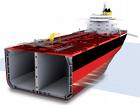 In 1990, in response to the Exxon Valdez oil spill, congress passed the Oil Pollution Act. One part of this law required that all oil tankers operating in U.S. waters would be required to have a double hull by 2015.
In 1990, in response to the Exxon Valdez oil spill, congress passed the Oil Pollution Act. One part of this law required that all oil tankers operating in U.S. waters would be required to have a double hull by 2015.
I’ve always been vaguely skeptical about this policy decision, and after reading up on it, it seems that this move less than optimal.
This excellent economics paper walks through a comparative statics analysis of the costs and benefits of the double hull mandate. It turns out that 64% of the oil spilled in U.S. waters results from operational lost; basically attrition caused by oil leaking into the sea or loose hoses, etc. Because U.S. waters are particularly dangerous from a grounding perspective, 23% of oil lost inside our territorial waters was due to grounding (only 10% of all oil lost in the rest of the world results from groundings). And, it’s not clear that a double hull would stop every drop of that lost oil. Even assuming that double hulls were impenetrable in grounding scenarios along with some other generous estimates in favor of double hulls, the paper concludes that the benefits due to the mandate are about half the costs. Again, this is the best scenario for double hulls.
However, there are ways to argue with this result. For example, the benefits to double hulls are calculated in terms of costs of cleaning up the spill, but there may be intrinsic value to otters and fish not dying due to blindness or poisoning (see this not very technical website). In other words, if an oil spill killed 1000 swimmers, we wouldn’t calculate the cost of this spill purely in terms of the cost of cleaning up the spill; instead we would add, to the money cost, the ethical cost of these deaths. Animals may have this same sort of value up to a point.
The problem is that this doesn’t really help defend the Oil Pollution Act of 1990, for two reasons. First, mandating that only double hull tankers froze tanker safety innovation. There are alternative hull designs that are superior to double hulls like mid deck tankers and Coulombi Egg tankers, but they aren’t built since they can’t be used near the U.S., which is a huge portion of the tanker market. In other words, our short sightedness not only prevented us from spilling less oil, but prevented other countries who are smarter from benefiting from new technologies.
Also, if we are serious about helping marine wildlife, we should just tax all oil lost in transit. This wouldn’t even be that hard to do since given knowledge of hydrostatics, inspectors could tell how much oil a tanker started a voyage with based on where the waterline was on the tanker when it left. Then, when the tanker arrived and before it unloaded, it could be measured again. All lost oil that leaked out into the ocean (either by attrition or catastrophic spill) would be taxed. That way, we could find the cheapest way of helping wildlife and even promote tanker innovation rather than decapitate it.
Also, we can’t really undo this legislation because since tankers take a long time to build, a bunch either have been built or are in the process of being built. Damn.
0 Responses to “double hull tankers, or, how to shoot ourselves in the foot”